Tenkara From Soup to Nuts; This is pretty much everything you need to know about tenkara fishing all in the one spot. Read on below...


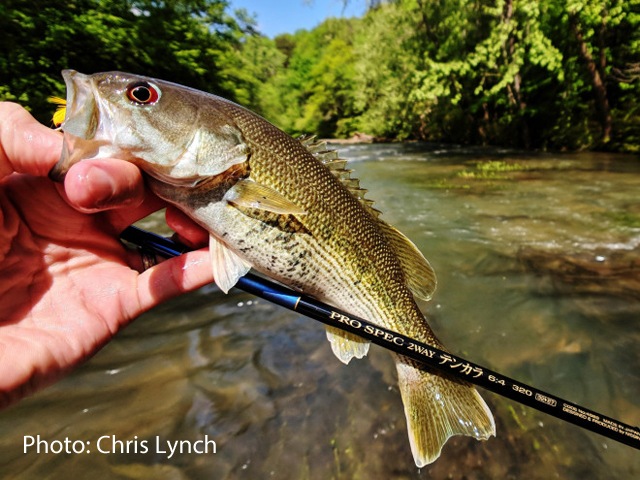


As well as set-ups, tactics and solving common problems we’ll bust a few myths and show you some sweet photos and videos.
Let's get started with a few FAQs:
Tenkara Fishing FAQ
What is tenkara fishing?
Tenkara is a method of fly fishing that originated in the mountains of Japan and has now developed into a modern pastime. It uses quite long rods, fixed lengths of casting line attached to the rod-tip and simple, impressionistic wet fly patterns. Most tenkara anglers attach just one fly at a time to the tippet. This method was developed to catch trout and char in free-flowing rivers using skilful technique and stream-craft.
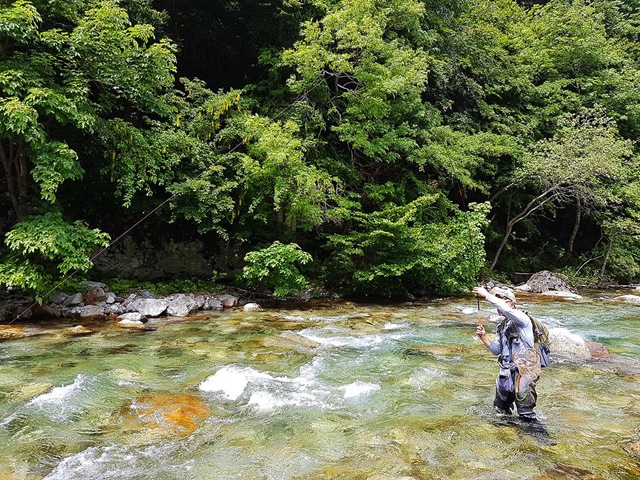
The word “Tenkara” is a shortening of “tenkara-tsuri” – a phrase that literally meant “Fly Fishing” in the traditional mountain-dwelling communities of the Tohoku region of Japan (and possibly elsewhere also). Calling this method of fishing “tenkara” was formalised in the 1980s by Yuzo Sebata through Japan’s famous “Tsuribito” (Fisherman) magazine.
How do you set up a tenkara rod?
Learning how to set up a tenkara rod can be frustrating if you don’t know the steps. Also, if you use the knots that most people recommend, you will dramatically weaken your tippet (the link above shows strong, simple knots). Most breakages of tenkara rods come during the set-up or collapsing of the rods before and after use. Use the golden rule: When you attach or detach your casting line NEVER have the rod tip exposed outside the handle-section of the rod. When you extend the rod, do it in sequence from thinnest section to thickest. For collapsing the rod start with the HANDLE/BUTT section first and work from thickest to thinnest. When collapsing each section, always hold the rod blank really close to each joint – especially for the thinner sections. If you grip the blank too far from the joint, the rod can bend and snap as you push the sections towards each other.
Why not just use a Fly Rod & Reel?
Well, one answer is that you CAN take the techniques used in tenkara and apply them very effectively when using “Euro-nymphing” rods & leaders. For example, the “Fly Manipulations” of tenkara will really multiply your success with Euro/Competition fishing methods (as well as dry fly and streamer BTW!). At the same time, I could talk about how portable and quick to set up these long telescopic rods are – but even more than convenience/portability there are some unique fishing advantages to tenkara gear. The lack of rod-rings/guides on the blank mean that MUCH finer and more flexible rod tips can be used. In turn, this means that they will effortlessly cast much, much lighter casting lines. With a long rod (tenkara rods are typically 11 to 14 feet long) and a super-light casting line, you can hold all your line off the water at range. This means that you can avoid spooking fish from the splashdown you get with fly line (and why you often need very long leaders to separate your fly from that “line-slap”). It also means that you can keep your line above nagging currents that would spoil your drift otherwise.
What happens when you hook a big fish on a Tenkara Rod?
A very common myth is that, because tenkara rods have a fixed length of line attached to the tip of the rod, they are only good for catching tiny fish. While the method developed in Japan to target small to medium-sized trout and char, the tackle can be matched to larger fish in a similar way that you find in other fishing methods (you don’t fish 2-weight fly rods for tarpon do you?).

"Honryu Tenkara" Specialist Kazunori Kobayashi with a huge tenkara-caught brown trout
As well as matching rod and tippet strength to target fish, you need to practice turning fish by using sideways pressure of the rod – as well as never pointing the rod towards a powerful fish. By steering a fish in an extended figure of 8 around the pool, you can change what would normally be a “reel churning” straight-line run into one or more laps around a curving “racetrack circuit”. Here’s a ton more info on how top Japanese anglers tackle big powerful fish in big powerful rivers known as “honryu”: Honryu Tenkara Article
How do you land a fish on a long tenkara line?
It’s a mistake to think you can only use a length of line that is roughly the same length as the rod. While this is often a good choice for accuracy and control, it isn’t unusual to use casting lines that are more than double the length of the rod (or even up to 12-metres/40 feet long); so you need to get good at catching the line as you draw back the rod-tip over your shoulder. DON’T start shifting your grip up along the rod towards the tip – keep hold of the handle and point the rod behind you. Reach forward with your “non-rod” hand (palm out) and sweep it sideways onto the line so that the pinky-finger/outside edge of your palm bumps into the line. Then gently close your fingers onto the line. Next, bring your rod hand (still holding the rod handle) DOWN to meet your other hand which is holding the line. Now you can draw line in “hand over hand” until the fish is close enough to net. The important thing is not to grip the line tightly – so that a twisting fish can tug line so that it slips out between your fingers. This acts like the “drag” on a regular fishing reel
Is Tenkara just “dapping” the fly under the rod-tip?
No, learning good, accurate tenkara casting is at least as skilful as regular fly fishing (in fact I’d argue it is easier to get started, but harder to get good at tenkara casting). The casting of ultralight lines lets you deliver your fly with a lot of accuracy while allowing extreme control over the presentation. That sensation of pinpoint casting by unrolling a neat casting loop is one of the main pleasures to tenkara fishing for many anglers. In tight quarters, roll-casts, slingshot casts, side-casts and all the usual fly-fishing tricks to get your fly out are all used in tenkara.
Tenkara Fishing 101: Setup Basics
As flagged up in the FAQ section, the fundamentals of knots, rigging the gear and extending/collapsing the rod (while avoiding breakages at all stages) are explained here: https://www.discovertenkara.com/tenkara-rod-setup.
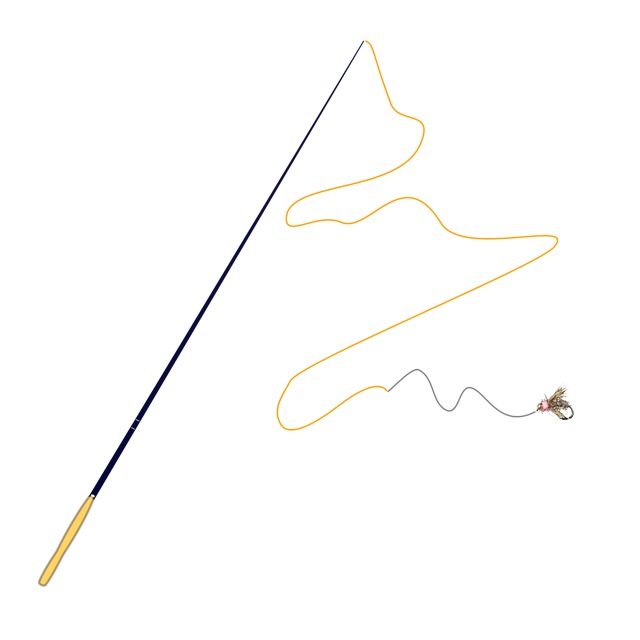
Don’t be tempted to skip over that part – because the majority of all rod breakages – as well as all losses of that “fish of a lifetime” - come from not paying attention to setting up your gear correctly. Having said that, as soon as you’ve got your routine nailed you need to start making choices on what you are actually setting up! If you are buying pre-made casting lines, you need to know how long they should be – and the guidance set out for choosing level line length will apply directly (no matter what type of line you’re using). Of course, this flags up another question…
You’re probably wondering “What type of line should I use?”. The full answer to that puzzle is given in the https://www.discovertenkara.com/ultimate_guide_to_tenkara_lines article.
If all the line-length choices are overwhelming, don’t worry. To get you started on a great path:
If in Doubt About Tenkara Line Setup Choices...
Start out with a #4 fluorocarbon level line that is about the same length as your rod (from tip to end cap) – and then add a length of 5x tippet that measures from the end of your outstretched arm to just behind your opposite ear. Fish a #12 stiff hackle fly either wet or dry and you're good to go.
To explain the tippet measurement in a bit more detail, imagine you are drawing an archery bow so the string goes behind your ear. The length of the (imaginary!) arrow is a good basic length for your tippet. Going beyond that simplified rule of thumb - find out when and how to vary that length of tippet to suit different tactics in this article https://www.discovertenkara.com/blog/tenkara-tippet-length/
Rod Maintenance – A Forgotten Detail
If you store a tenkara rod while it is still wet from the river or rain – the finish on the surface of that rod will bubble and be spoiled. Even worse, if you have some grit inside the rod sections, over time it will wear away at the blank and create a weak spot. Then, one day, you’ll get an “unexplained” breakage without warning. There is very little promotion of the best ways to do this – one of the first good practical demos I saw of this was Masami Sakakibara’s “car park tutorial” below:
Just be careful when you get to the really fine sections –don’t stuff too much tissue into those! It is easy to get a piece of tissuestuck – and very difficult to get it out…You might need to shave down a bambookebab skewer to make it thin enough to poke through!
If you have a spot in your house that is well ventilated, then an option is to simply wash the sections out using a bathroom shower. Afterwards, lay the sections flat in a warm spot where the air is actively flowing. If you lay them in a spot without ventilation they will remain wet almost indefinitely – so it’s really important to check that you have active air flow.
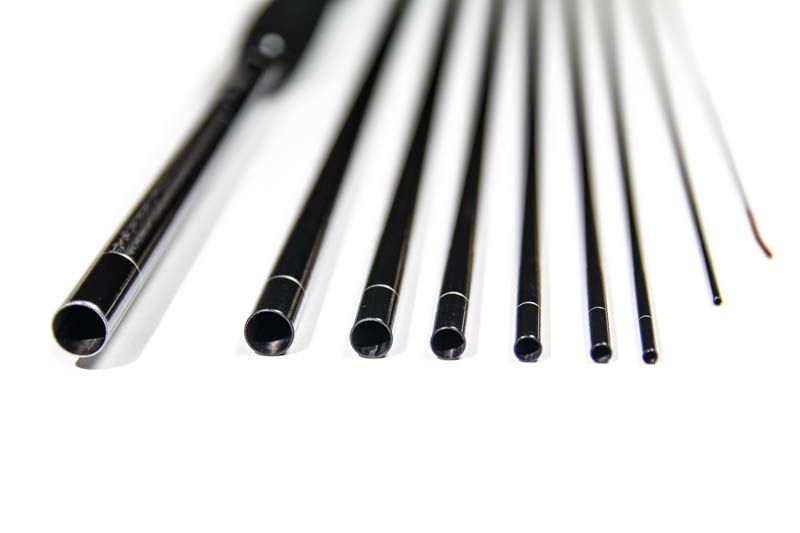
As a final point on gear, you can click on the following link to find out all you need to know about tenkara rods.
Now for some tactics…
Tenkara Fishing Techniques
Tenkara Casting
The point where most anglers fall down is by trying to cast a tenkara rod and line using exactly the same casting stroke as you use with a fly rod and fly line. Several tenkara rod manufacturers in the West are actually built around using heavy “fly-line” type casting lines with rods that have a slowed-down (but relatively stiff) action. In this way, the modified tenkara-style tackle can be forced to fit a normal “fly fishing” style ofcasting.
The trouble is, by doing that, you lose all the major benefits of tenkara.
Holding the casting line off the water and the ability land the fly (and nothing else) on a very precise spot are huge advantages. Casting a heavy fly line out horizontally and letting it fall onto the water does not give you access to those benefits.
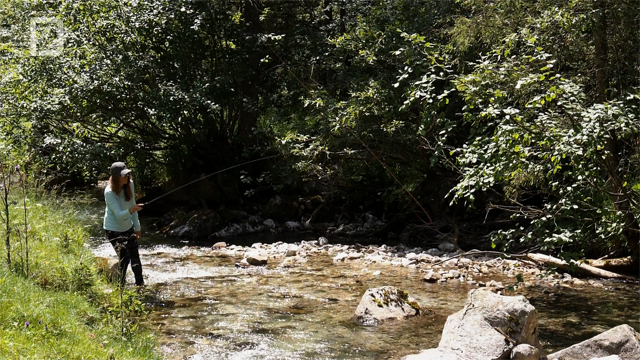
Instead, a MUCH shorter casting stroke – and a lack of a pause between the back-cast and the forward cast – are needed. Click the link to this article to get a full breakdown of how to develop a good tenkara cast for yourself: https://www.discovertenkara.com/tenkara-casting.
The basic summary is that the overall plane of a tenkara cast should be angled diagonally downwards towards the water – and that a short, quick (but not over-powered) casting stroke is needed. Learning to only squeeze the rod handle during the middle part of the casting stroke is a tiny –but vital – detail. By relaxing the grip as you “stop” on the forward cast, you avoid the rod-tip and line rebounding back towards you. That small detail smooths out your loops and increases your accuracy and control greatly.
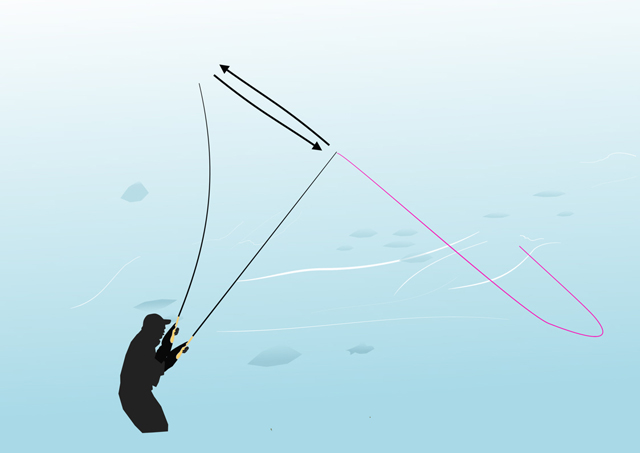
The idea is, wherever possible, to land only your simple, single wet fly (and nothing else) at the target point on the water. This is what we call a “fly first” cast and it means that both your fly and your casting line land exactly in the perfect fishing formation.

In tenkara fishing – DON’T use the wide arc and horizontal loops of good fly-casting
Your fly is fishing effectively from the moment it lands on the water – and you don’t need to correct the position of your line to create a great drift. By avoiding line-splash, the fly first cast also greatly increases your chances – as there is a much smaller chance of spooking a fish. This brings us on to…
Perfect Drift with the Perfect Fly
For probably more than half your time on-stream, all you will need to catch fish during the warmer months of the year is to master a great dead drift (or natural drift) presentation.
That is why developing a great fly first cast is important. If you cast upstream (or up and across the stream), allowing the fly to splat gently on the water and then tracking that fly, your tippet and your casting line downstream can create a very enticing offer to a hungry fish. For the full effect, do this with everything held off the water – apart from enough tippet to allow your fly to fish at the desired depth.
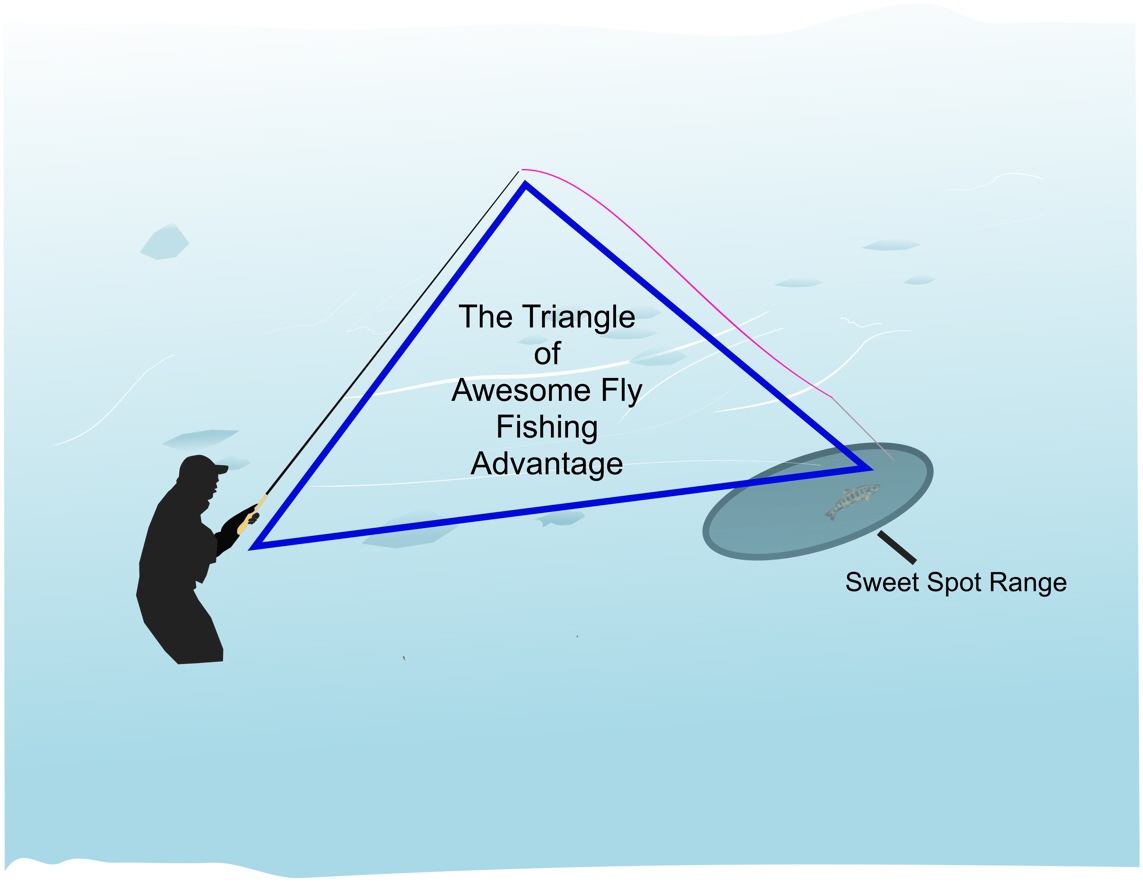
Upstream-cast followed by dead-drifting: The Triangle formed by rod & line is a huge advantage
That desired depth might be right on the surface or – for unweighted flies – maybe a foot below the surface (see the honryu tenkara article for information on tenkara tactics with weighted Japanese flies).
In most streams, the best idea is to use a drift time of between only three and five seconds as a rule. This helps to avoid spooking fish by “lining” them before they have seen your fly. You can find deeper-level expert tips on creating an amazing drift in Part 1 of an Expert's Guide to Tenkara.
As far as knowing what fly to choose – starting out with a simple stiff-hackle wet fly in a size 12 or size 14 will get you a long way on all kinds of river with all kinds of insect hatches. You'll find a great crash-course in Japanese tenkara flies here. N.B. all fishing flies in Japan are known as "kebari" (roughly translated as feathered hook).
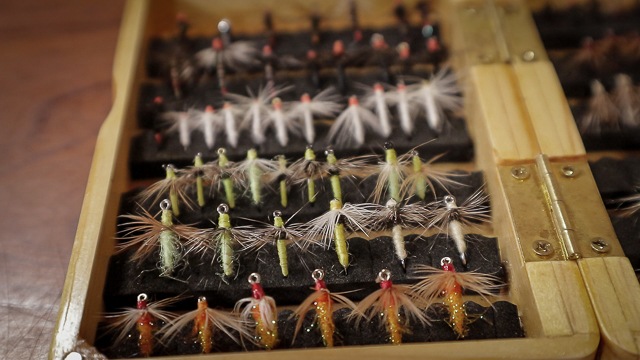
Stiff-hackle wet flies – like these created by Kazuo Kurahashi – are the most common tenkara pattern by far
![1 Jun Set With Label[2]](http://www.discovertenkara.com/wp-content/uploads/2019/07/1-Jun-Set-With-Label2.jpg)
The next most common style of tenkara fly is the “jun” kebari (typically rear-sloping soft hackles, but can also be stiff hackles wrapped in a conventional "western" style)
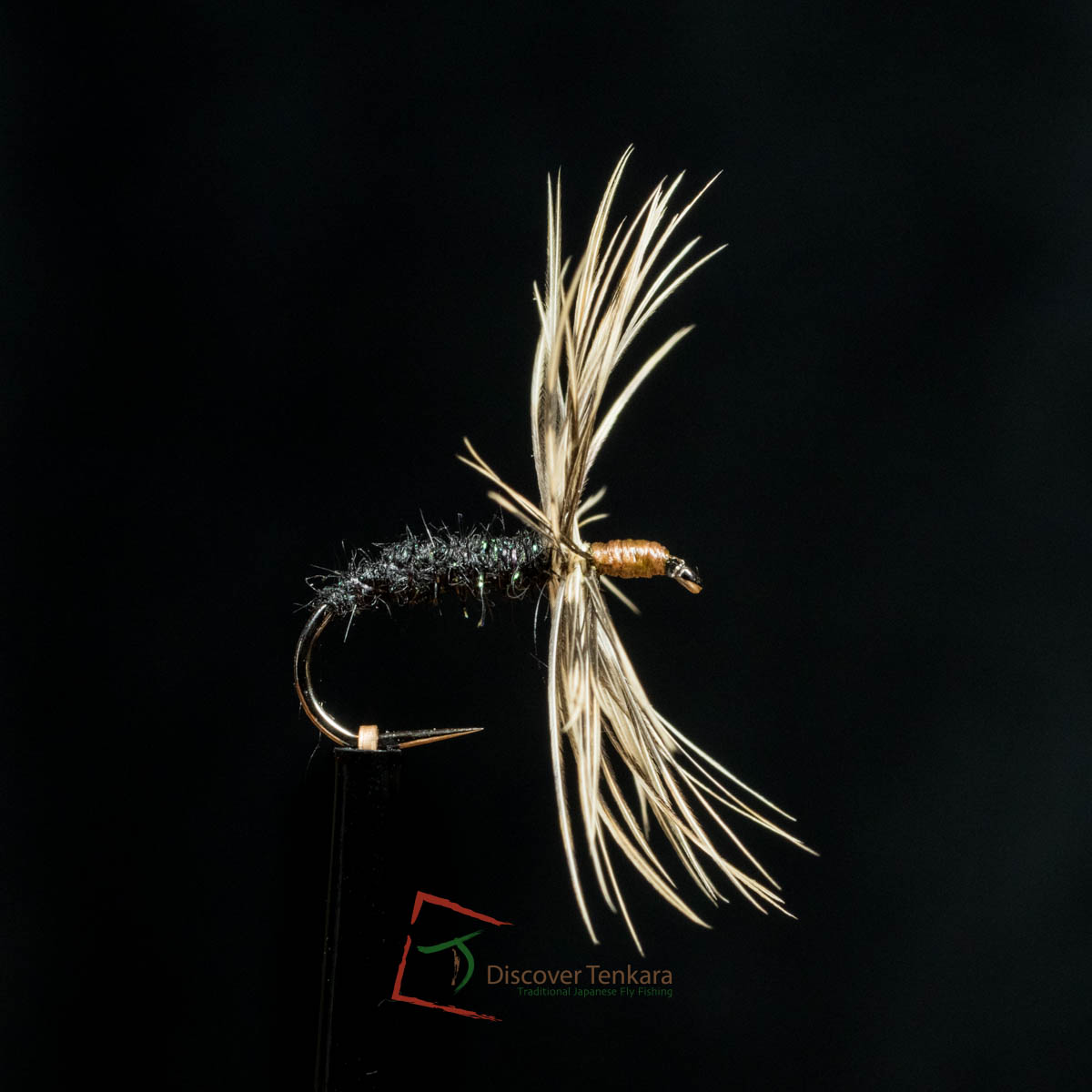
Reverse hackle flies (sakasa-kebari) are the least-common and yet most-iconic part of the tenkara fly Universe!
If you'd like to know how to match the ideal fly to its perfect presentation method – you’ll find what you need in “How to Fool Fish with Simple Flies”. The book actually gives you a complete method for making every important choice in your river fly fishing tactics (a topic that needs its own book to bottom out properly).
How do you detect strikes when tenkara fishing?
The moment of truth when a fish takes your fly! But will you even know?
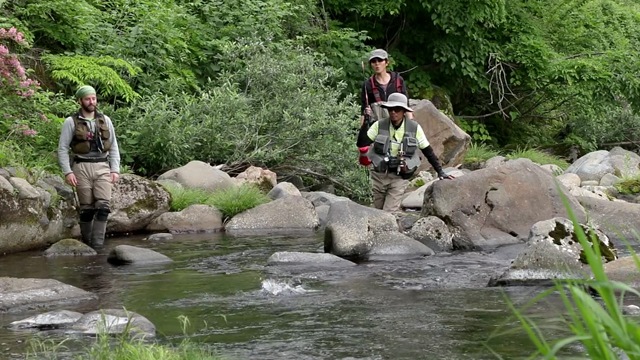
YES! Hook-set and a fish is on the line
One of the advantages to starting out with an unweighted fly is that a fish needs to move high in the water to grab it. There is actually a good argument for applying some floatant to a stiff hackle wet fly and fishing it “dry” to get the party started with your early efforts at tenkara. In both cases, as long as you are tracking the drift correctly with your rod tip (and your eyes), there’s a good chance that you will actually see the fish move in the water and grab your fly. That is the time to flick your wrist back and set the hook.
If you are fishing a bit deeper in the water and/or the conditions of the water make it impossible to see beneath the surface, then you will need another form of strike detection. The main way to do this is to watch your tippet (when you can see it) or your coloured casting line as you hold it off the water and track downstream. In this way, your full line can act as a strike indicator. You should NOT rely on feeling the fish grab your fly when fishing dead drift.

What you are looking for is any unnatural-seeming movement or pausing of the line as you track downstream with your rod-tip. If you need to watch your casting line (which is one of the reasons that tenkara lines –including level lines – are coloured), it is best to watch the junction between the tippet and casting line. This is the closest point to the fly itself and is more likely to give the greatest sensitivity to any strikes.
As another “training method” to help you get the hang ofthis when fishing a sub-surface fly could be to add a small tuft of yarn (treated with floatant) at the junction between the casting line and the tippet. Only make this as large as you need to see it. If you make it too big, it spoils your casting and also makes it difficult for you to progress to the point where you no longer need it.
If you do use a small yarn indicator, make sure to get good at holding it back at the end of your casting stroke, so that your fly turns over well and lands first. Also get used to holding all your line off the water – right up to the indicator. Both of these “muscle memory” exercises will make it much easier to transition to removing the indicator and progressing in your fishing skills.
Approaching the Water for Tenkara Fishing
Stealth
One of my favourite sayings in all fishing is “First Scare No Fish”. In the history of the planet (and unless they foul-hooked it), nobody has ever caught a spooked trout on a fly. When it is in that state, it will not feed on anything – let alone your artificial fly. So, if you don’t want to spend your life waiting for fish that you previously spooked to come back on the feed again, you need to learn stealth.
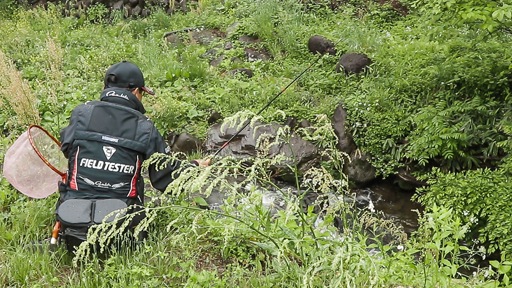
Kazunori Kobayashi crouching to avoid spooking fish while fishing a small stream
Of course, with a fixed-line method such as tenkara, stealth can be especially important – but there is a flip side to this. There are many situations that fish have a much harder time sensing your presence. When this happens, you could be wasting a lot of time and effort on hiding from fish.
That time and effort is probably better spent actually fishing – so it is important to understand how and when to use more caution. One of the very best anglers we’ve seen applying this on stream is Kazuo Kurahashi. Along with his extremely effective fly patterns, you can get the complete A to Z of his highly developed stealth tactics from Kura-san's Masterclass online course.
Never forget that, when you take care to hold as much casting line off the water as possible (and use a fly first cast), there is a lot of stealth already built into tenkara. Other basic things to keep in mind are:
- Try to position yourself so that there is something to break up the eye-line between the fish and your position
- Be careful of the sun direction – so that you can avoid casting a shadow on the water where you want to fish your fly
- Don’t just plough a direct line through the river; think about moving out and around to try different angles on a fish
- Make less noise, disturbance and fly (or line) splashdown in flat, shallow pools
- Keep your body off the sky-line whenever possible (and use a longer line when you have no cover)
These are the things that most people fall foul of. They seem to forget that the best cast, fly, rod, line, drift, sunglasses (or whatever else) in the world cannot catch a fish you have spooked before you cast to it. As a result, this is where you can steal an unfair advantage by paying more attention to this area.
Reading the Water for Tenkara Fishing
In Japan, a section of water that is particularly suitable for tenkara can be said to have “kei-so” or a “good tenkara face”:
Kei-so
Definition: Boulder-strewn clear mountain rivers with lots of current seams, pockets and features that fish can hide and feed in
The mixture of broken and flatwater allow anglers to get close to fish and also provide a good variety ofcurrent-speed to help present a fly effectively.

Italian River with good “kei-so” – Ideal for Tenkara
At the same time, a lot of anglers don’t realise how much of an advantage the light casting line (and the ability to hold a lot of it off the water) can be in flat, clear sections of river too.
While it usually takes a long time to develop the ability to read a river well, you can gain a significant advantage by knowing just a few pointers to help you out:
- The boundaries between fast and slow water aregood ambush points for fish to attack insects and small fish
- Rocks that break the flow are also worth attention – fish can lie below them but also just above them using the soft “cushion” of water that forms on the upstream side.
- Any “drop off” from shallow to (even slightly) deeper water
- The foam line running down from a riffle (a great “conveyor belt” of food)
- Overhanging, trailing or submerged vegetation (including stems, branches and foliage – whether that is bamboo or alder!)
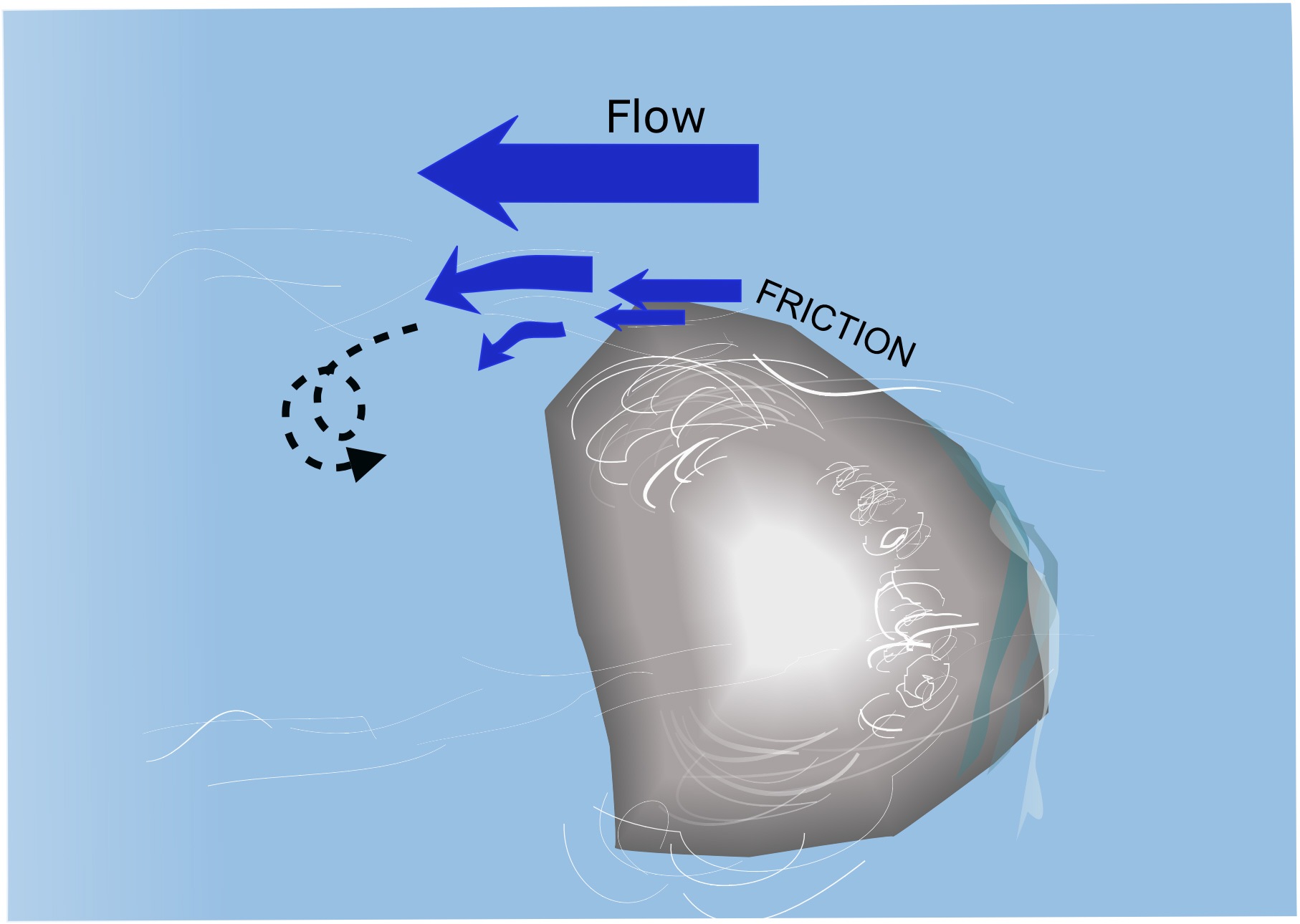
Pay attention to the eddying currents around boulders
It is also important to test out different features of thes tream with your fly – particularly on a day when fish are feeding well. This will reveal other fish-holding lies that you should concentrate on in your own streams and rivers.
Japanese Tenkara Fishing
As long as people keep fishing tenkara in Japan, they will always have been doing it longer than anyone else. That should mean it isn’t a huge surprise that they’ve learned a trick or two over time…
Because of that, there is a ton that we can learn from Japanese tenkara developments – from traditional to modern sporting incarnations. First I need to tackle the elephant in the room though.
"Japan-o-phobia": Watch out!
It has been said that we don’t worry about the traditions of spin fishing and plastic lures – so we don’t need to pay any attention totenkara’s back-story from Japan. For me, that is missing a huge trick. It also isn’t quite correct – I think we’ve all grown up with our own familiar fishing stories. Whether it is tales of catching perch on a worm under a bright bobbing float or that big grand-daddy bass that couldn’t resist a weedless popper twitched through the lily pads – we all have our folklore that adds the magic to fishing.
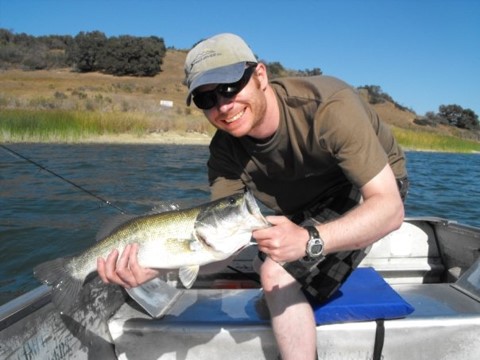
Here I am with a largemouth caught on lure-fishing gear from Lake Casitas, California
For instance, there are far more fans (and members of societies dedicated to) Izaak Walton in the USA than there are in his native England. I’ve been lucky enough to see the “fishing house” and fish on that same beat of the River Dove that Charles Cotton and Izaak Walton fished together. Catching fish from the same pools that appear as lithographs in “The Compleat Angler” undeniably adds to that experience.

Charles Cotton/Izaak Walton Fishing House on the River Dove, England (photo: Neil Gibbs CC BY-SA 2.0)
The difference with tenkara’s back story is that it is all told in Japanese – and not many anglers in the West are either fluent in that language or have grown up in that culture. We take for granted everything we absorb without realising inside our own fishing culture. When it comes to the same type of automatic knowledge of Japanese fishing, the page is totally blank.This is a shame, because as a country, it is full of extremely talented and dedicated anglers.
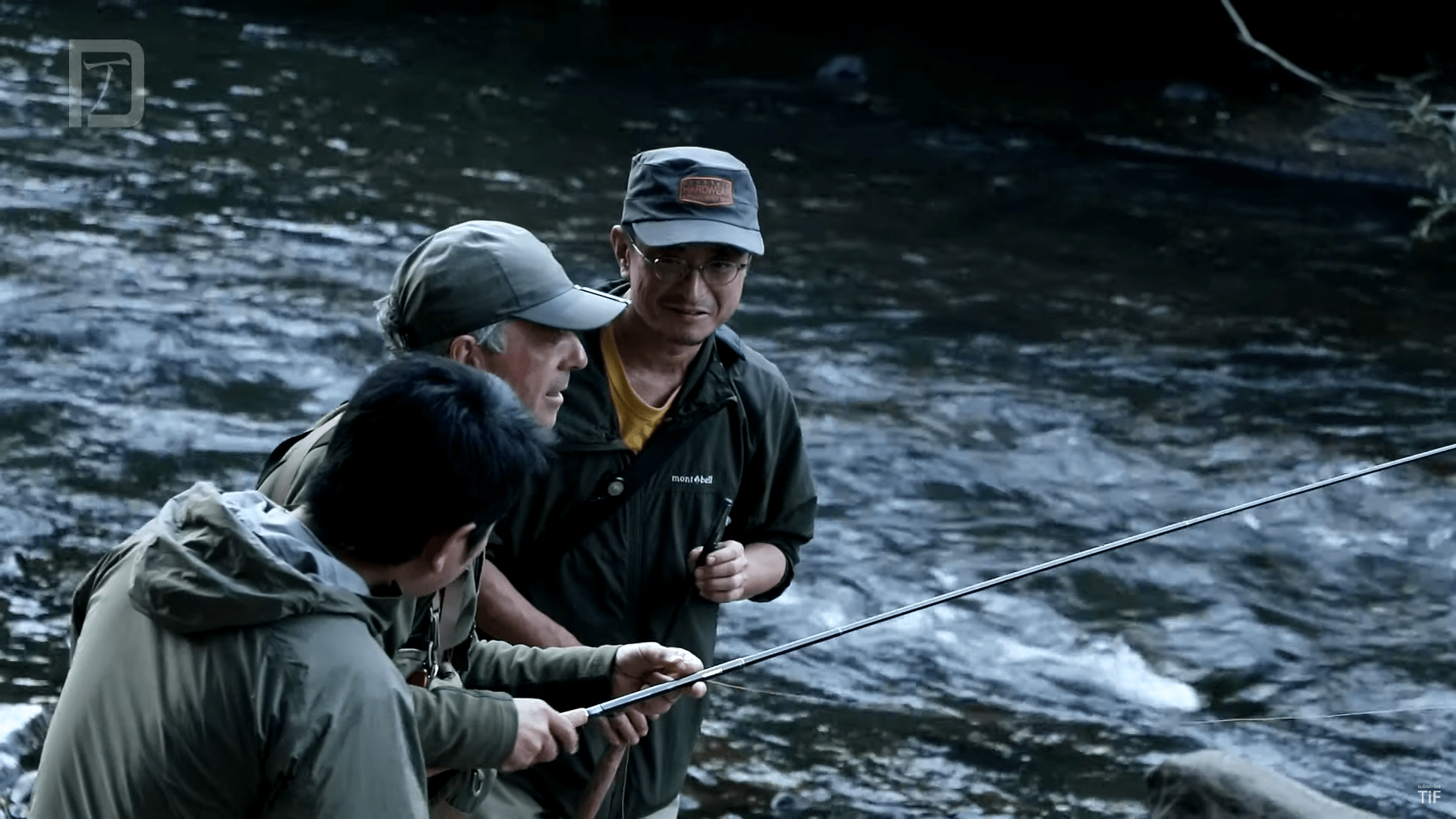
Kura-san and Go Ishii giving pointers and encouragement to Alan Swann on a Japanese river
Even more ironically, Japanese anglers welcomed and adopted the methods and culture around American bass fishing – and then became avid fans and high-level practitioners for themselves. Japanese anglers didn’t see it as silly “purist” snobbery to have that interest – they devoured as much information as possible.
That being said, the spread of catch and release outside of (American influenced) fly fishing and bass fishing has been slow to non-existent. So I’m certainly not saying one culture is universally “better” than another.
“Tenkara the rod” vs “Tenkara the Method”
While Japanese tenkara is not the only fishing method that you can use a tenkara rod for (as you’ll see later in this article); it is a perfectly designed fit. Just like we have respected figures in fly fishing (past and present), Japanese fishing publications have the same. Would it not raise a few eyebrows if a Japanese fly fisher said that Lefty Kreh had nothing useful to say on the subject of fly casting?
Therefore, tenkara as a whole activity and approach to flyfishing is more than only a kind of rod. It is a collection of techniques and a way of thinking about the challenge of fooling fish with artificial flies.
Personally, I don’t think people need to be afraid of examining and learning from Japanese tenkara and the culture and people surrounding it. After all, there must be a reason that tenkara addicts in Japan will drive between 5 and 12 hours each way for a weekend of tenkara fishing in the mountains!
The Environment of Japanese Tenkara
Soils and climate create each distinctive variety of wine. The tenkara fishing of Japan is, in the same way, strongly flavoured by the terrain where it developed. Lush, forested mountain slopes, heavy snowfall in winter and bursting with life in summer - Japan’s main island alone is said to contain over 20,000 fishable mountain rivers.

Namedropping: Dr Ishigaki and I fishing in Itoshiro, Japan
The volcanic salts dissolved from rocks that filter rain-water create stunning blue, clear, cold streams that are home to beautiful trout and char. Japanese mountain rivers, contrary to some popular opinion, also support massive and diverse hatches of insects.
A lot of traditional Japanese art features many layers of misty mountains fading into the distance. This is exactly what you see today when travelling up into the highlands. All kinds of bamboo - as well as conifers and deciduous trees - grow on the slopes. The small settlements (each with their own rice paddies) in these areas are VERY different from the dense cities where most of the population is concentrated. Surprisingly, around 80% of Japan consists of forested mountains – so it’s much wilder than many foreigners believe.
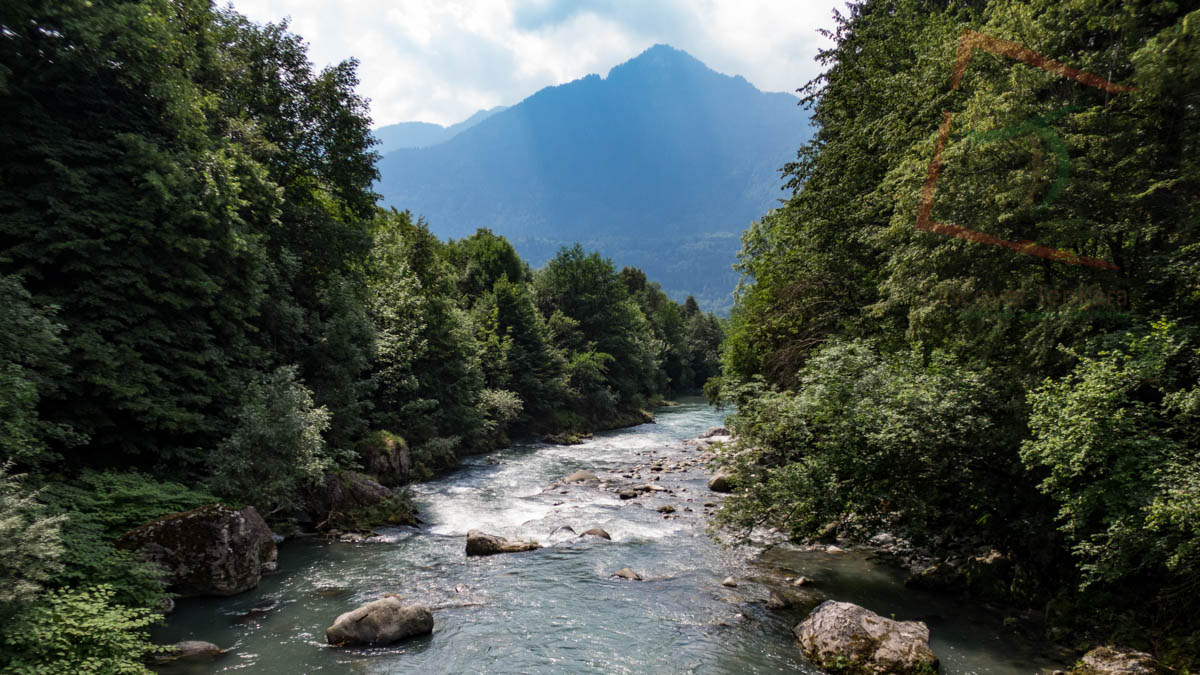
As well as the beautiful, steep, clear rivers the mountains are also a source of prized wild edibles that include lots of young plants in spring and fungi later in the summer. A knowledge of those edibles is a very important factor to people who either live or spend time in the mountains.
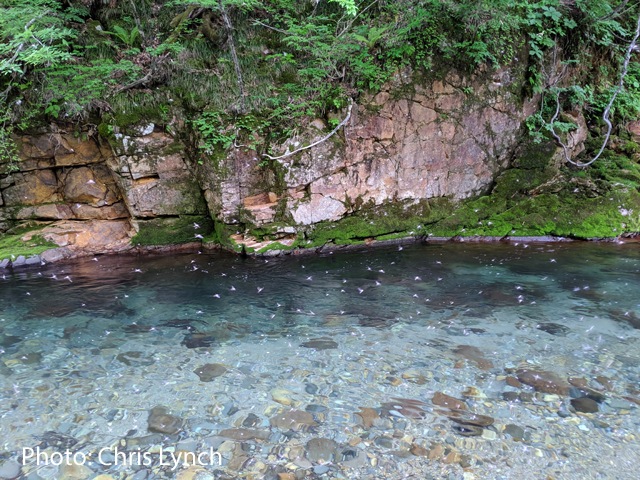
Standard Mayfly hatch in Itoshiro, Japan
The main myths about the rivers and environment for tenkara are:
- Few insects/sparse hatches X (hatches are richand diverse as already mentioned)
- There must be no wind because people fish tenkara X (absolutely not true)
- There mustn’t be any tree-lined streams X (again, tree-lined streams are common)
- It is only for small streams and small fish X (if you already saw the Honryu Tenkara article, you know this is false)
If you are a trout fisher, the fact that tenkara is perfectly adapted to catching shy fish under those conditions should get your interest up. It means that Japanese tenkara tactics are likely to give you an edge on your own trout rivers and streams. Speaking of trout…
Typical Fish of Japanese tenkara

Japanese “iwana” – White-spotted char
In Japan the three main species targeted and prized by tenkara anglers are Iwana (white spotted char, above), Amago (rain-child, below) and Yamame (Lady of the mountains, below amago photo).
The latter two are trout species in the same genus as rainbow trout. They tend to be much more shy than rainbows and they are incredibly beautiful fish. They like to hunt on the edges of faster tongues of current.
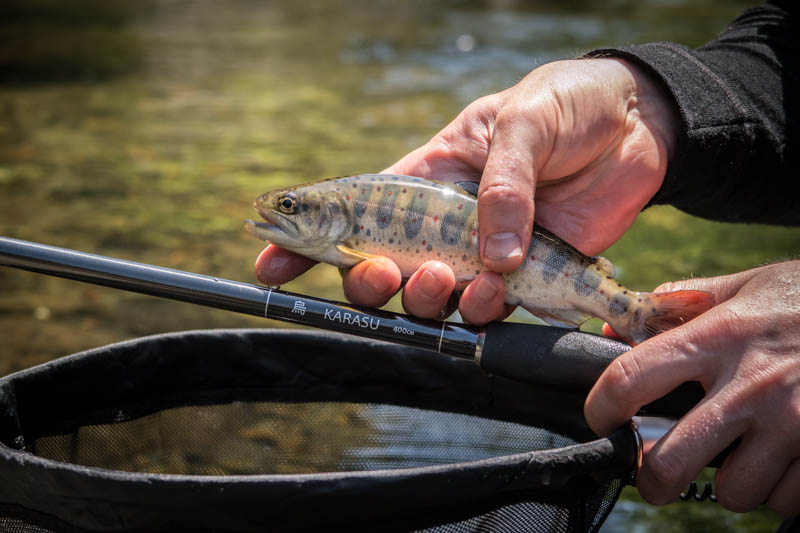
Amago or “rain-child” trout from Japan
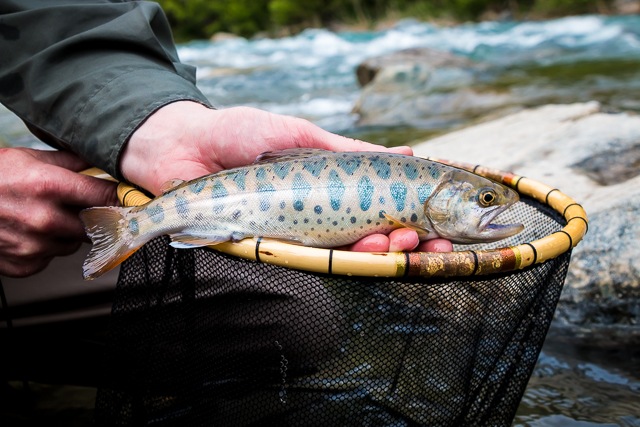
Yamame “Lady of the Mountains” trout from Japan
Iwana can be quite similar in appearance to some brook trout– but they lack the electric purple spotting. They are very much “ambush predators” and like to sit in the slack spots around boulders.
What does this mean for those of us with an interest in tenkara – but who do not live in Japan?
OK, there are a few places you might find these species outside of Japan (there are some yamame and the sea-run version known as Cherry Salmon in Korea, as well as Japan, for instance). Don’t despair though – it turns out that there are many places around the world that you can find fish that respond and behave in a really similar way. Perhaps these can be thought of as “Japanese Substitutes” or a home-from-home collection of tenkara fish.
For example, in Europe and America there’s a wide range ofcoldwater trout and char that really fit the bill. While there is obviouslysomething unique about the Japanese experience, there are rivers and fisharound the world where you could really hone your “Japanese” tenkara fishingskills.
Here are just some examples…
Substitute “Japanese” Tenkara Fish
Brook trout – a wonderful fish for tenkara; present in somebreeding populations in Europe as well as the North American continent.
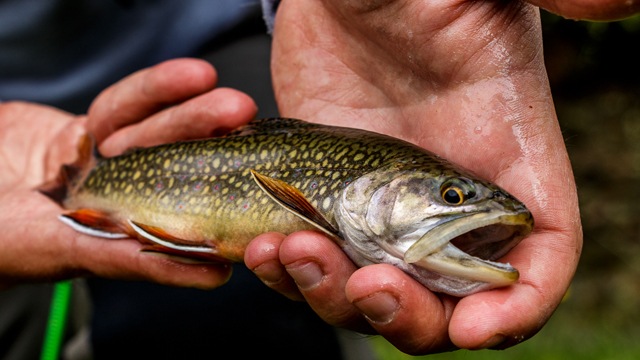
Italian Brook Trout
Brown trout – Incredibly adaptable; possibly the specieswith the greatest genetic diversity of any known vertebrate. This lets it filla great many ecological niches and exhibits a wide range of behaviours.
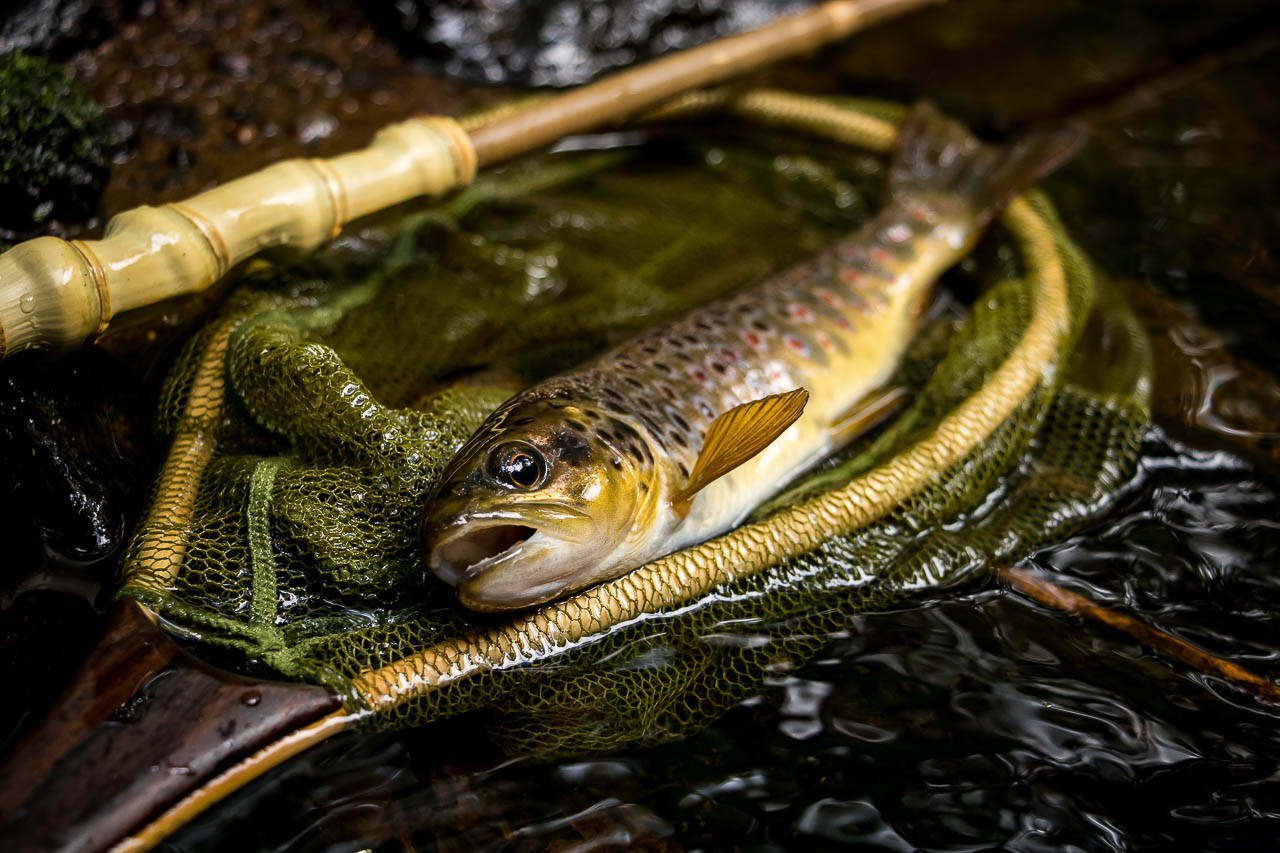
Brownie and a bamboo tenkara rod with traditional horse hair tenkara line
Cutthroat trout – beautiful inhabitants of mountain streams; including the famous but endangered greenback cutthroat trout of Eastern Colorado/Southeast Wyoming
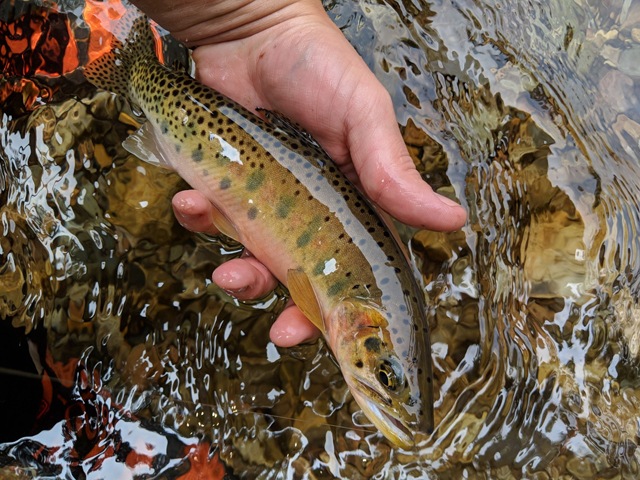
Cutthroat from Idaho – caught and photographed by Daniel Butsick
Marble Trout – Another rare and beautiful species of theNorthern Alps of Italy and over the border into Slovenia.
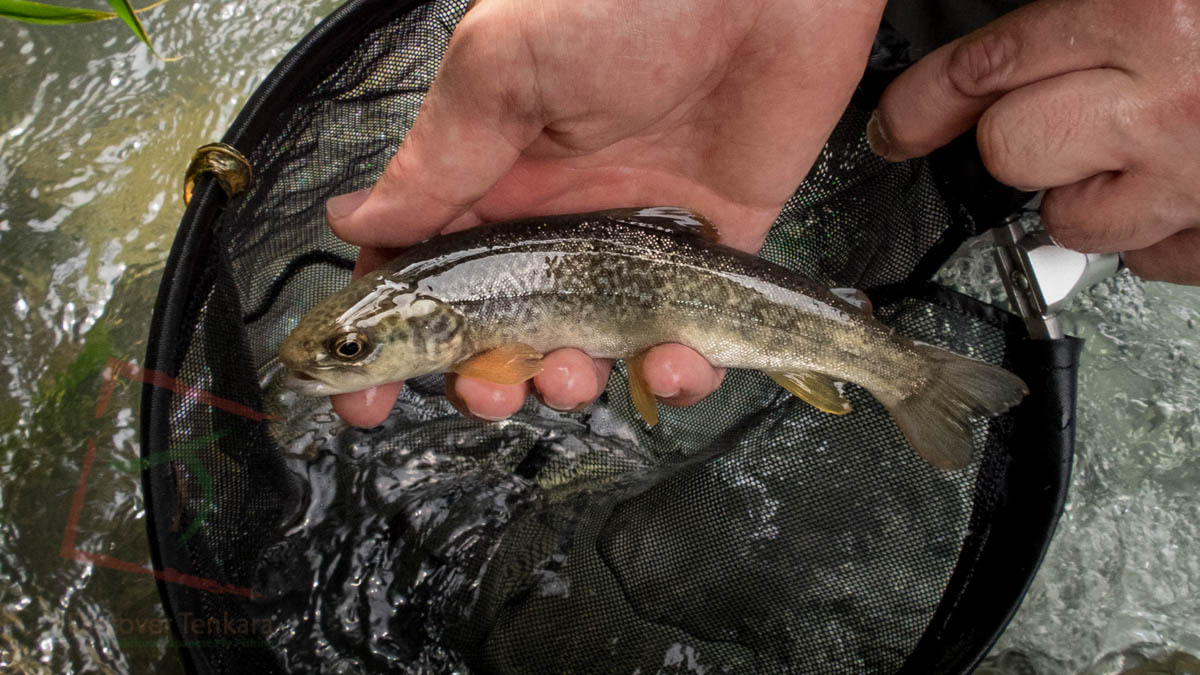
A lovely little marble trout for JP from the Dolomites
Grayling (Arctic and European) – Although not having a similar species in Japan, grayling inhabit some types of water that are a good match to tenkara techniques. Overall, though, the favoured zones for grayling would probably be towards the slower reaches of rivers tackled by tenkara anglers in Japan.
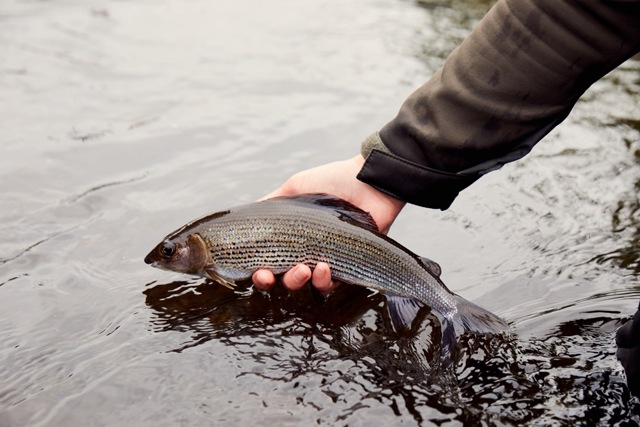
European Grayling caught on tenkara
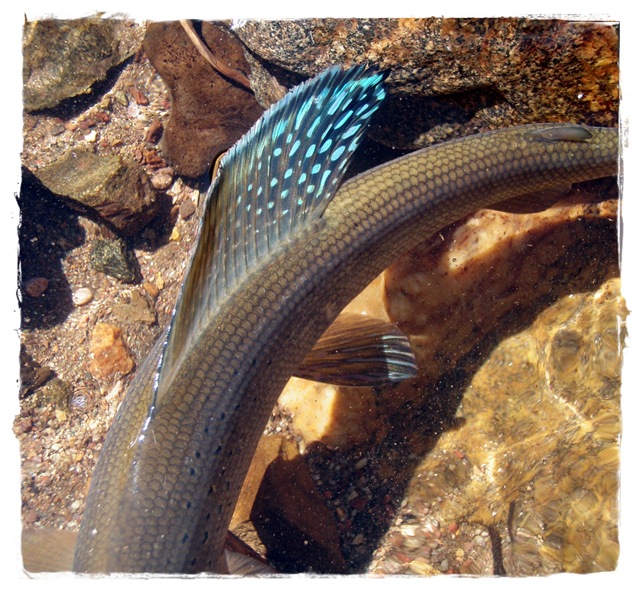
Arctic Grayling fin – caught and photographed by Anthony Naples
It is probably fair to say that grayling are a good candidate for a crossover species into warmer-water fish that can be targeted using modified, western techniques.
Mountain Culture
The values, skills and knowledge that people who live in the mountain areas of Japan all strongly flavour the practice and enjoyment of tenkara. You need to have a very strong connection with nature – to understand the dangers and the opportunities. Weather cycles for farming, fishing and (historically at least) hunting for survival are important to understand. Fighting against nature is a recipe for disaster.
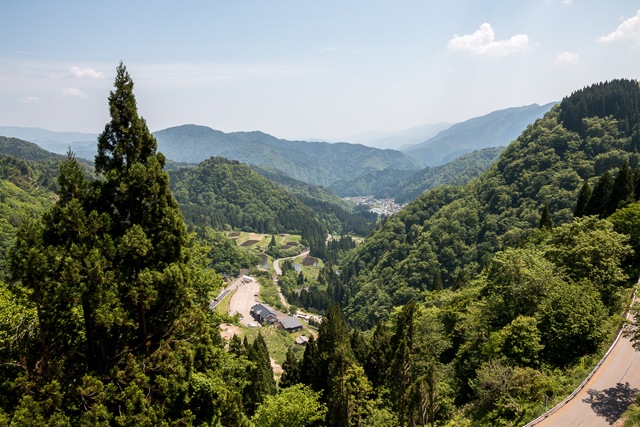
The switchback pass up from Shirotori to Itoshiro in Gifu Prefecture, Japan
Maybe the perfect example of keeping in balance with nature is the knowledge of sansai (wild edible plants) and kinoko (edible mushrooms). Not only do you need to know the season, conditions and locations to forage for these – you also need to know how to AVOID TAKING TOO MUCH.
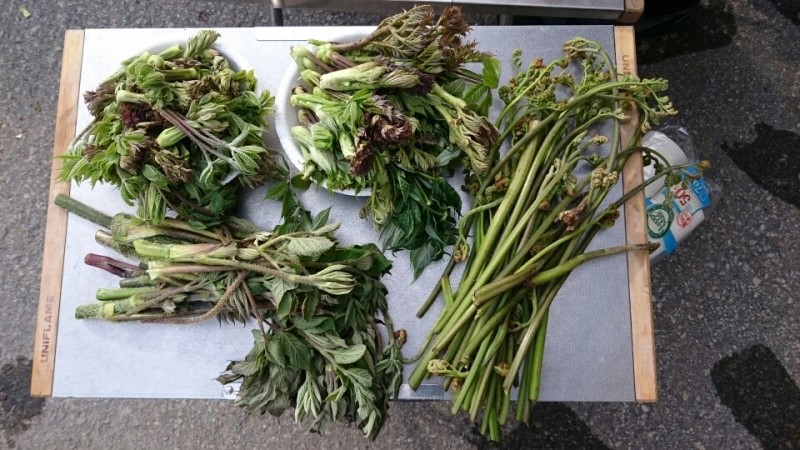
“Sansai” wild edibles gathered by Kazumi Saigo
It’s vital to know how much of a patch of each foraged food to leave so that it can regenerate. That understanding of how to take part in the balance of nature – without destroying it – is essential to mountain living.
In the ryokan and minshoku inns of the mountains, locally-gathered sansai and kinoko are big components of the menu that you will be served. To put that into context, you don’t often see the managers of a Best Western going out collecting local wild herbs, vegetables and morels ready for your evening meal.

Locally-foraged sansai and locally-caught iwana served at Yuzanso Inn, Akiyamago Japan
Mountains have always been incredibly important in Japanese religion and art. Yuzo Sebata (one of the most important figures to have shaped tenkara over the last 50 years) is very concerned that mountain culture has not been exported from Japan as part of tenkara. In a direct conversation with us, Sebata-san said he is disappointed and worried that the culture of the mountains and of tenkara has not been introduced overseas alongside the rods.
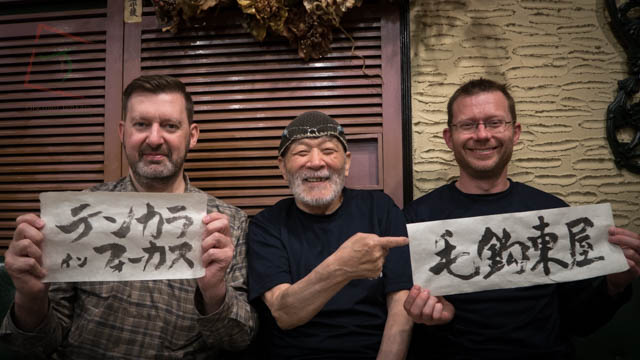
Our first meeting with Yuzo Sebata (centre)
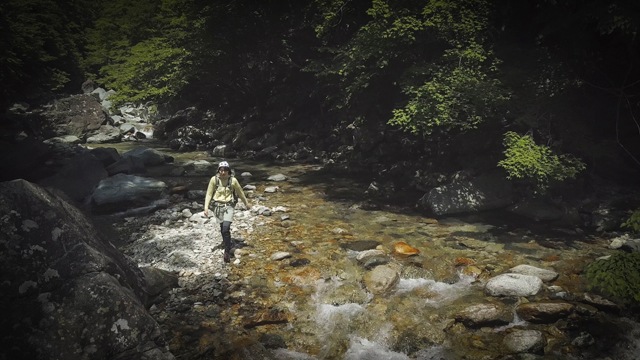
There’s a new generation of tenkara anglers, such as Goto Yoko, who have strong skills in climbing, foraging and rough-camping. In this way the new and the old mountain cultures co-exist in Japan.
To gain more understanding of this – a great place to start is the article on the Shokuryoshi (the original tenkara anglers).
The thing that I realised with a bang this summer was a trip to the Italian Dolomites. I was talking to local anglers there about the Shokuryoshi and the delicate balance of life/death in those unforgiving environments. As part of the Q&A after showing a film on Shokuryoshi and tenkara, the comments were that a lot of their culture was almost exactly the same. The foraging for wild edibles, keeping things in balance (even down to the wild mushrooms we were served in the pasta at our hotel) and connection with the natural world all had the same importance. They even have bears roaming the upland forests to match with the Japanese mountain environment.
The central importance of bears to the “matagi” (and hence shokuryoshi) is explained in this article if you want to understand more: https://www.discovertenkara.com/matagi
Traditional Tenkara Fishing
Now that we know who/what the Shokuryoshi and Matagi are, it is much easier to separate out what traditional tenkara would look like compared to the modern sport form. Although becoming a rare breed, we have been lucky to spend time with two, surviving shokuryoshi during our research trips to Japan. By combining that with visits to museums of shokuryoshi and matagi artifacts and cultural notes, we’ve tried to gain at least a basically accurate picture.
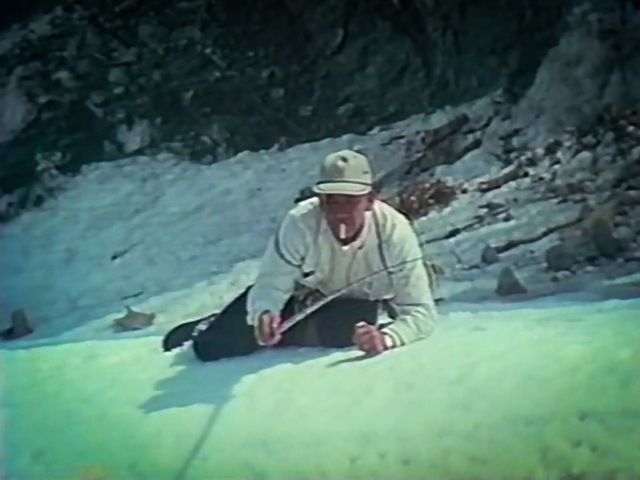
Shigeo Yamada in the 1970s: Akiyamago’s best known Shokuryoshi of his day using his 1-piece bamboo rod
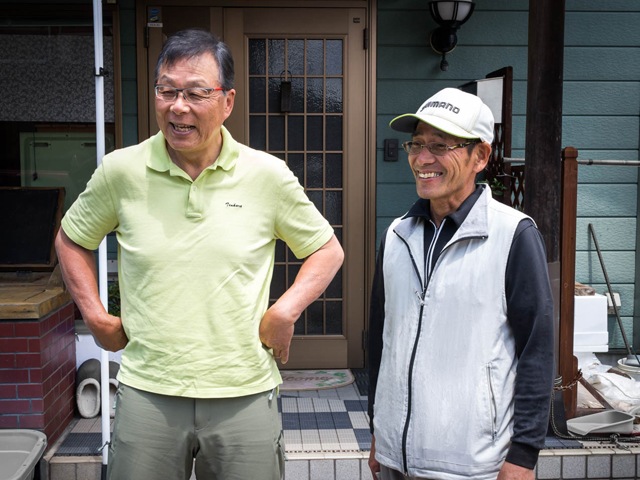
Dr Ishigaki (left) with Hisanobu Hirata (right) a professional shokuryoshi who now owns a tackle store
The tenkara of the shokuryoshi would typically involve single-piece bamboo rods – and with quite a powerful action for landing and dispatching fish quickly. The furled horsehair casting lines would be proportionally a bit heavier than many modern tenkara lines – although perhaps not so much as you’d imagine. This is partly down to the special casting stroke that allows light lines to be cast with fairly stiff rods that both Yamada san and Hirata san (shokuryoshi) showed us.
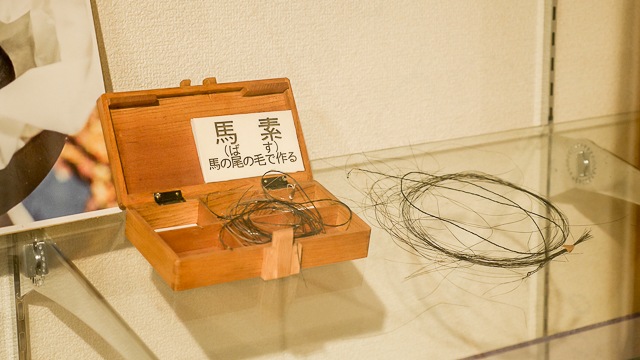
Original Shokuryoshi “basu” horsehair line
Originally, tippet would be made from silk-worm gut or, possibly, horse-hair if gut was unavailable. As for many historic fly fishing methods in the west, the original tenkara flies would be tied on sewing needles. These were heated and bent into shape and the hook and fly (or “kebari”) was often dressed directly onto the tippet. Other patterns may have had looped cord to form an eye that tippet could be tied to.
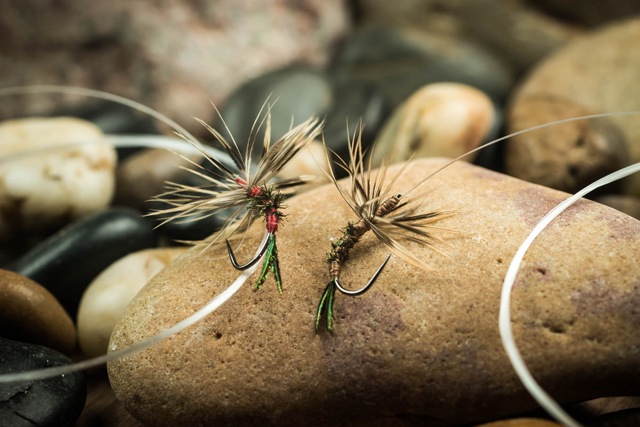
Tenkara kebari dressed directly to tippet
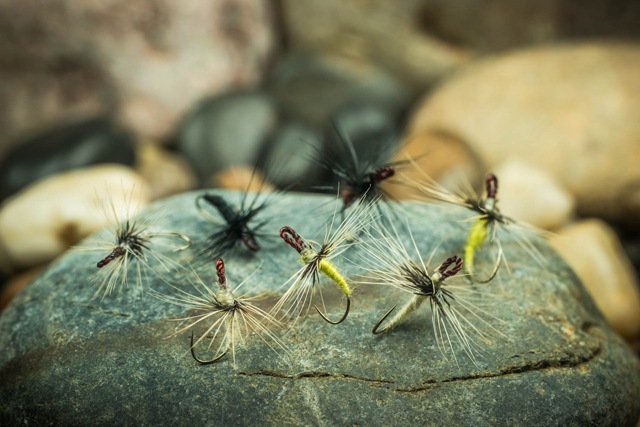
Traditional kebari from Itoshiro, Gifu tied by Shouichi Saitou
Hackles were most rooster feather and the flies for this style of “survival” fishing would tend to be pretty rough and ready. Yoshikazu Fujioka has collected together a fascinating photo-gallery with notes of all the traditional fly patterns he has managed to discover by travelling to different mountain villages in Japan.
Because of the lack of a written history of these methods and flies, it is possible that they have been practiced for very many hundreds (or even over a thousand) years. There are credible origin stories of matagi arriving in Akiyamago around 400 years before present and seeming to bring tenkara with them – as explained in my complete tenkara lowdown.
Modern Sport Tenkara
The 1960s saw the beginnings of the transition of tenkara from survival method to pastime. It was around this time that fish farms would bring down the market value of wild fish. Large dams were also being built on many rivers that had previously been prime fishing grounds for shokuryoshi. At the same time, Yamamoto Soseki had become fascinated with the methods of fly fishing that his dentist Dr. Fujimoto taught him.

Following in Yuzo Sebata’s footsteps and using the skills of the Shokuryoshi: Modern genryu tenkara (photo: Keiichi Okushi)
Today, tenkara in Japan has evolved down several routes - with two major branches being the hardcore "genryu" crews exploring the most remote, inaccessible mountain headwaters and the ultra-technical light-line keiryu and honryu anglers raising the bar on the most challenging fish. Keiichi Okushi has created a great series of articles on modern genryu tenkara here.
But before looking at where we've ended up today, it is worth understanding the transition from shokuryoshi to sport...
Soseki’s writings still form an important part of modern tenkara culture today. In fact, Dr Ishigaki (who is, at the time of writing, the de facto international ambassador for Japanese tenkara) belongs to what is known as “The first generation after Soseki”.
Here was a small collection of people who were rediscovering and becoming fascinated by Japan’s traditional fly fishing. Their interest translated into publishing books, articles and - in the case of Dr Ishigaki - TV series sharing the methods and culture of tenkara. The full series of those programmes has a guest list that reads like a “who’s who” of modern tenkara – including Masami Sakakibara, Yuzo Sebata, Katsutoshi Amano and more. Here is the first episode of Dr Ishigaki’s TV series from the mid 1980s:
One really interesting point is, the unique casting style of Takekabu Keiyū – who was using relatively stiff 3-m long rods to cast 8-m level nylon casting lines. His forward cast looks more like the casting stroke you see in shokuryoshi who use stiff rods also (though the extremely extended back-cast seems to be unique). The stiffness of his rod and the power of his hookset often sent fish flying as you can see in the video! Catch and release/fish survival studies would not be well known in Japan at that time – so these videos are very much a document of their times.
Contrast it to Amano-san’s casting of an 8m tapered line in the same episode (and Dr Ishigaki’s typical “modern” tenkara cast) both using a more compact casting arc – like the one taught earlier in this article. One modification that Amano-san uses is a more circular motion that helps to keep his loop narrow and under constant tension – as well as keeping his fly from hitting the rod (even when casting into a headwind).
The video shows how well Takekabu-san can hold that light casting line high off the water to reach across fierce currents. This leads on to…
The rise of full-flex rods
The advantages of light casting line make a perfect tool tohighlight that, nowadays, many of the top “sport” tenkara anglers choose verysoft/full-flex rods with the lightest casting lines possible. These soft rodshave excellent “recovery”, and load easily even with very light casting lines.That means you get the benefit of light lines, without needing a more effortful“extended-throw” type casting stroke (highly skilled though that is).

Kazuo Kurahashi using a long, soft rod and a light casting line
The combination of light casting line, excellent (pinpoint-accurate)casting skills and full-flex rods is a strong feature of the highly technical,cutting-edge “sport” tenkara anglers of today. These tactics are necessary forsuccess on the very difficult rivers of Japan – where angler traffic and/or thesize and power of the rivers are a severe test of skill.

Masami Sakakibara – one of the most talented tenkara casters you will ever see
This is where you see the modern masters such as Yoshiyuki Mushu, Masami Sakakibara, Shin Takahashi, Kazuo Fujiwara, Kazunari Kimura – and the next generation cutting edge anglers such as Kazumi Saigo, Kazuo Kurahashi and Go Ishii really shine. The subtle layers and various techniques of “Sasoi” or “Inducement” movements of their flies are also a key part of this modern,highly technical tenkara. Sasoi is very much highlighted as an important partof tenkara and explored in Dr Ishigaki’s TV episode above.
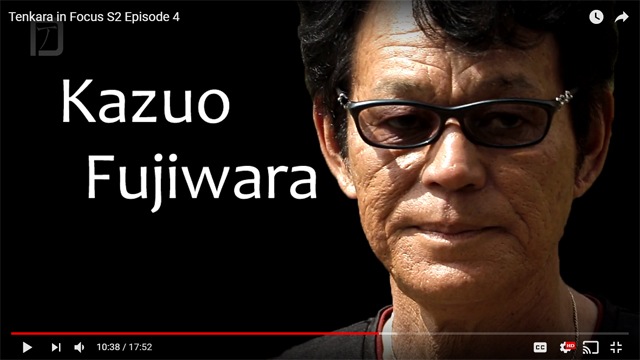
Kazuo Fujiwara – badass tenkara master interviewed in Season 2 of Tenkara in Focus
The whole subject of fly manipulations (which just happen to be significantly enhanced by soft actioned rods with good recovery) is very detailed. A quickstart guide – including how these secret skills are an unfair advantage in regular fly fishing too – is available in this article: https://www.discovertenkara.com/blog/fly-action-part-4/
With the significant refinement by talented anglers ondifficult rivers, the best modern “sport” tenkara anglers in Japan have createda very rich approach that draws on traditional roots and knowledge. At the sametime, the easily recognisable spirit of historic Japanese tenkara has beencombined with space-age materials to create those refinements.
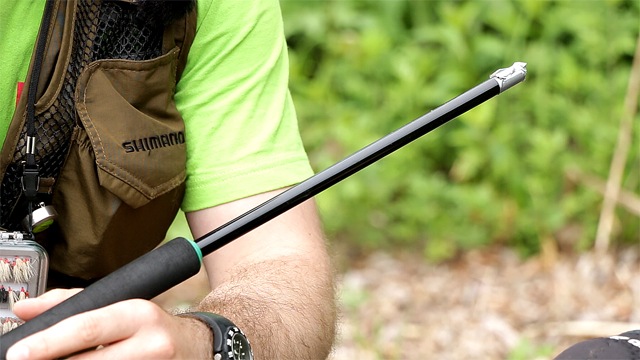
Uberto Calligarich with his customised 4.5-m Daiwa Rinfu – a legendary (and now discontinued) light-line, full-flex tenkara rod favoured by many top, modern tenkara anglers

Cutting edge tenkara meets modern competition skills in Kazumi Saigo
Because the best Japanese tenkara anglers are highlyskilled, they are often fascinated to learn about other highly-accomplishedriver fly fishing schools and traditions from abroad. A particularly obviousexample is the interest in Euro-nymphing tactics that anglers such as KazumiSaigo and Shin Takahashi have shown.
In fact, Shin Takahashi has such a long and well-established base of Japanese tenkara, his keen interest and melding of European competition nymphing tactics into his fixed-line fly fishing makes a great bridge to the next section…
Western “Tenkara Rodding” Methods
Although there will be people who disagree, I want toexplain when and why I use the term “Tenkara Rodding”. It’s a phrase I finduseful to describe those times when I’m fishing western fly fishing methodsusing my tenkara rod. Now, you might say “Yeah, but we already have the term“fixed line fly fishing” for that.
There’s a good chance that you’ll be pissed off at me for not just calling everything involving a tenkara rod “tenkara”. That’s a slightly different question and I’d point you back to Sebata-san’s concerns and comments over the potential loss/dying out of valuable culture if we only import the rods and not the knowledge from Japan.
If you accept that – then my reason for making “tenkara rodding” a label is that tenkara rods are not the only surviving “fixed line fly fishing” rods (or FLFF for short!!). For that reason, I think FLFF belongs as a higher level heading.
Why Add Another Label?
Traditional, reel-less forms of fly fishing such as “Frusta Fiorentina”, “Scurriazzo” and la “Pesca a mosca Valsesiana” in Italy – plus traditional methods from Serbia, Bosnia and Spain – are all perfectly described as Fixed Line Fly Fishing.
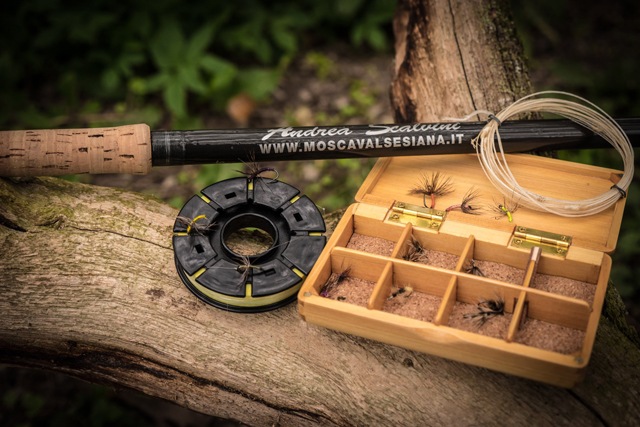
Mosca Valsesiana rod, line and flies (with a tenkara spool thrown into the mix for confusion!)
For me, I’m using the phrase “tenkara rodding for bluegills” in the same way that I’d say “fly rodding for tuna”. It gives a picture of the situation and tackle that are likely to be a bit different from the usual state of play.
I could also say something like I was “tenkara rodding with Euronymphs” last week. You can put tenkara tackle (or Valsesian tackle) to manydifferent uses if you want to – and with solid technique it’s going to workreally well for you. However, only using a single label for everything you cando with a tenkara rod isn’t very helpful for people wanting to learn thedifferent methods and approaches.

Chris Lynch Tenkara Rodding for Alabama Red-eye Bass
In fact, having a few different named categories is reallyhelpful when it comes to more subtle blends of two styles. For instance,Takahashi-san’s use of nymphs with his fixed-line style has a lot of elementsof tenkara techniques as well as the ways that European and American competitionanglers present their flies.
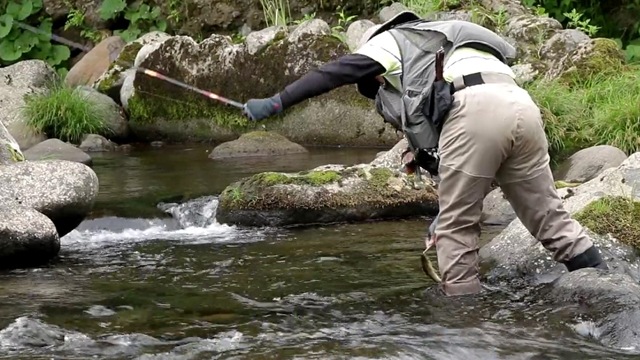
Shin Takahashi using his C&R tool while tenkara nymphing in Itoshiro
For that reason, a useful label there might be “Tenkara nymphing” – and to find out more here’s a full article and video interview on Shin Takahashi’s Tenkara Nymphing.
For all the points above – the labels are used to show things that are “Different but not Less”. Anyone who is interested in the tenkara fishing of Japan is always made welcome there. Let’s return the favour by not dismissing the original methods and culture as “elitist”. Yeah there are folks who just want to rain on your parade and be “right”, but you’ll always find one or two folks like that in any sport (and I can’t think of any Japanese anglers like that!).
Nymphing in RIvers
Whether it is winter fishing or just a deep, powerful river where the fish don’t often feed near the surface, using competition nymphing tactics with weighted flies is an effective option. In western fly fishing, long, supple rods that are specially designed for this style are used.
The lightness and even longer/more supple rods of tenkara are a great advantage when fishing in this style. Of course, developing good fish-landing skills on a fixed line (including handlining – where care must be taken with dropper flies!) is essential and potentially a little more difficult than fishing with a reel. With either rod & reel or fixed line rods there are trade-offs of different advantages to be made.
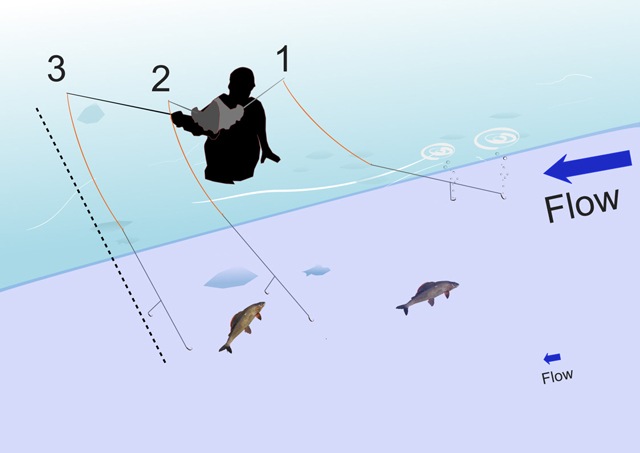
“Short-line” nymphing for grayling with a tenkara rod
In the UK – winter grayling fishing would be a classic application of tenkara rodding nymphs.
The biggest thing to be aware of is the great care you needto take to avoid hitting the rod blank with a weighted fly (tungstenbead-heads will cause invisible damage that will fail later – even those timeswhere they don’t break the rod outright).
Some people also prefer a slightly stiffer/more tip-actioned rod (perhaps rated a 7:3 on the Japanese flex profile scale) for fishing larger bead-heads. This might help with the hook-set percentage for weighted flies fishing at depth also.
Dry Fly Fishing
Using a tenkara rod with one of Fujino’s factor-taperednylon tenkara lines is one of the greatest ways to delicately present a dryfly. The length of the rod means that a lot of the casting line can be held offthe water – and the lightness of the nylon casting line makes it land verygently. That line also takes floatant well and it is very easy to pick off thewater with little disturbance or “spritz”.
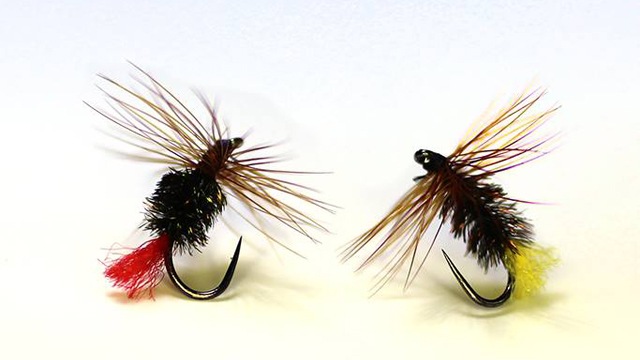
Traditional English Dry Flies can work brilliantly fished from a tenkara rod (photo: Rob Smith)
It is even possible to move closer to a Japanese tenkara presentation by using a light level line and holding all the line and tippet off the water up to the dry fly. We often use this as a great stepping stone to taking the plunge with traditional single wet-fly presentations. Having a fly floating high on the surface makes it easy to practice accurate fly-first casting – as well as making it really obvious when a fish grabs your fly.
Whether you add floatant to a stiff-hackle kebari or you use classic western dry flies, both of the above presentation methods are really effective fish-catching tactics.
Streamers and Poppers
Both streamers and poppers can be easily fished using a relatively heavy level fluorocarbon casting line (say a #4 or a #4.5 on the Japanese diameter scale). For poppers you probably want to grease up any portion of your casting line that will lay on the surface. A long and more powerful than average tenkara rod is advised to help you cast those larger flies – as well as set the hook effectively. Some people also find success by using the running line from a standard floating fly line as their casting line for this method (and there could be an advantage when throwing highly air-resistant poppers).
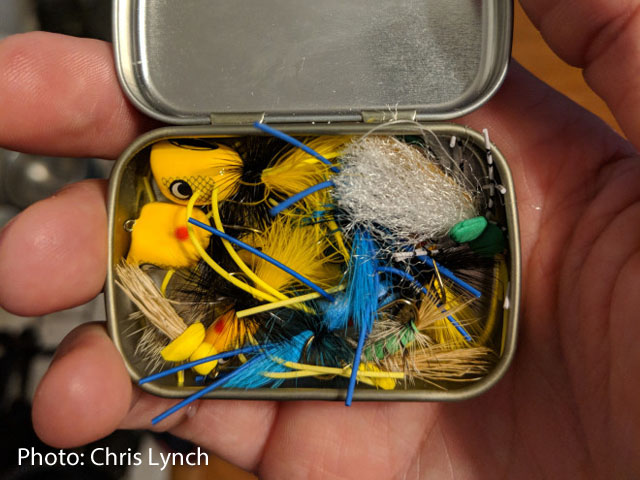
Poppers for Bass & Panfish
While it is worth carefully weighing up whether using a fixed line set up offers more advantages than a regular rod/reel combo for this style. It might be possible that the extreme portability of the rods and the capacity to hold a lot of casting line off the water with a relatively long rod could be worthwhile.
Warm Water Fish Species
Depending on the climate where you fish, you might have rivers that share a lot of current features and characteristics with colder mountain streams and rivers. In those locations, fish such as smallmouth bass – or even the lovely Alabama Red-Eye Bass that Chris Lynch wrote about in this article for Tenkara Angler. By modifying the size of your kebari – or by using regular western patterns – you can practice many of the presentation techniques you’d be using in Japanese mountain streams.
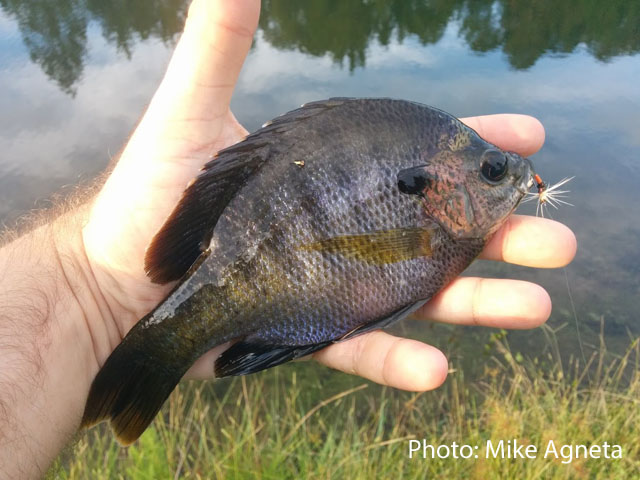
Chunky Bluegill and sakasa kebari
Of course, there is viable fishing to be had in slow, low gradient streams, canals (and even ponds) using tenkara rod and line setups. In all cases, it is good to practice fly-first casting and getting the very best advantage out of any breeze. Of course, great positional sense and knowing how and when to use extra stealth are all just part of solid fishing skills – whether you’re using a tenkara rod or not. Bob Long Jr. contributed a detailed article on his Smallmouth Bass fishing to TA here.
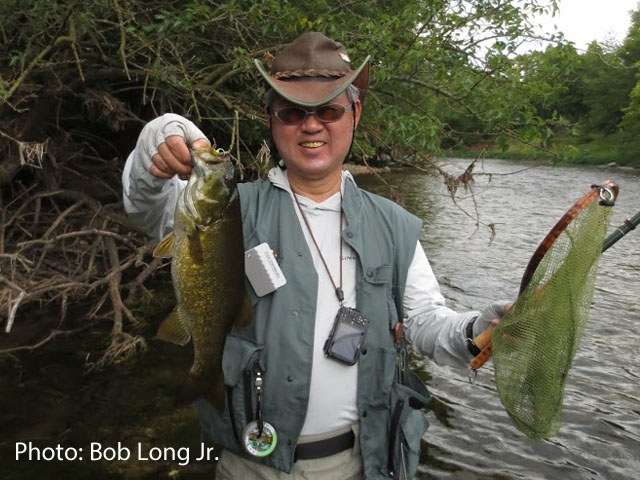
Nice Smallmouth landed on a tenkara rod
Many tenkara rod owners enjoy targeting chub, roach, dace, rudd, perch and other species found in slower water. I always enjoy the variation of fishing expeditions that feature in David West Beale’s “Tenkara Tales” blog – and I think you probably will too.
For a whole host of the species mentioned, having a broad range of the Japanese fly manipulation (Sasoi) techniques in your back pocket can turn a tough day into a red-letter one. Of course, there will be times when it’s “natural drift or nothing”, but you can’t rely on that every trip out.
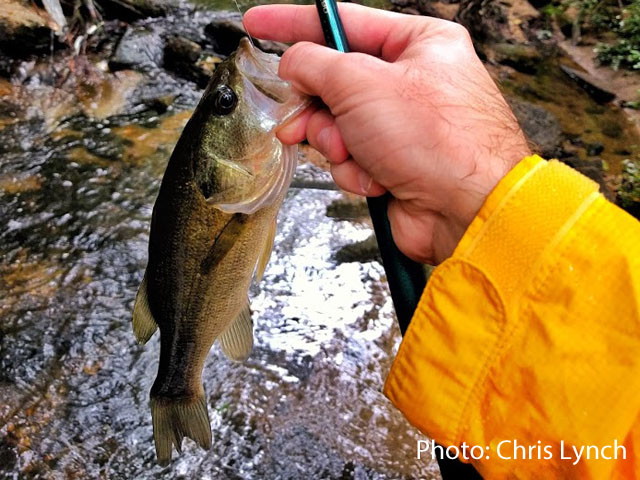
Manipulated flies and largemouth bass go together very well
Finally, for warm water fish, we have been known to test rods and tippets by targeting carp with tenkara rods. Although people have landed much larger carp (using more powerful rods) the fish in the 3 to 6lbregion that we’ve tackled on “honryu” tenkara rods are really powerful.Certainly those fish are strong enough to give you confidence in tacklingbigger trout in rivers using the same class of gear.
I think it is a nice feeling to know that you can be tenkara rodding for a warmwater species one day – and then the next fishing Japanese tenkara for coldwater trout and char. As I said earlier, the labels and the appreciation for the wide variety of methods and cultures is a positive thing when used with a generous spirit.
Whatever your own fishing with a tenkara rod looks like, respect and learn from the hard work and culture of tenkara’s originators. At the same time, understand that tenkara rods and techniques can turn all kinds of fishing venue into an adventure.
Learning the techniques and not just how to rig the rods isreally important and powerful. For instance…
Tenkara Fishing Using Fly Rod & Reel
I would hesitate to call this just “tenkara” – because nobody in Japan would really consider using a fly rod to fish tenkara with. Having said that, taking pretty much everything that you’d do with a true tenkara rod and line and then applying it to appropriate “western” fly tacklecan be incredibly effective.

Marryat Competition Nymphing rod, simple wet-fly paired with a furled nylon line inspired by those used by Yuzo Sebata and Shouichi Saitou: Tenkara presentations work wonders on this rig.
The only condition that I’d add is that, even with very light AFTM-rated fly rods in the 10ft to 11ft region, you do get some extra casting accuracy, range and manipulation control with a true tenkara rod. That being said, it is a matter of degree – not an absolute “all or nothing” situation. What I mean is, you can cast accurately enough and create subtle enough manipulations with a good Euro-nymphing rod.
I can tell you one thing, spending time learning really goodtenkara skills will take your western traditional wet fly fishing to the nextlevel. In fact, I’d say exactly the same thing for your Euro-nymphing – and even specialist dry fly and streamer fishing as well.
But even when it comes to taking a purely tenkara approach – you can get great results on rod and reel. For instance, let’s say you try anchoring a stiff hackle wet fly in a back-eddy using tenkara level line (attached to your fly line in the same way you would a French leader). There will be almost no anglers on your river exploiting that kind of presentation opportunity.
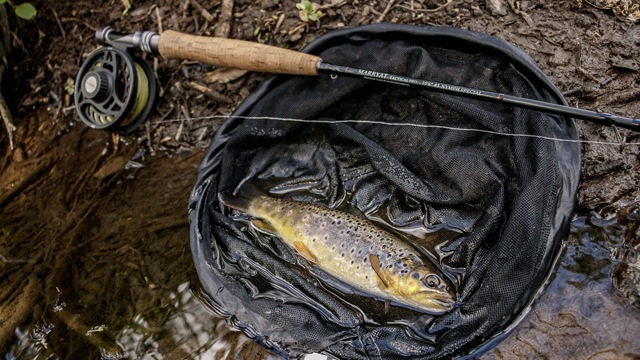
Rod & Reel plus crossover tenkara tactics strike again
I can tell you from experience, that creates some fantastic fishing experiences and stories for the memory vaults and diaries.
Did you like this?? If so, share it on your Social Media accounts, blog or by email. It’s good karma - plus your friends will know you’re awesome…
Paul Gaskell
